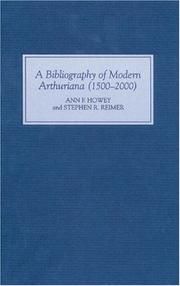| Listing 1 - 3 of 3 |
Sort by
|
Multi
ISBN: 9781843844211 1843844214 9781782045915 1843845008 1782045910 Year: 2015 Publisher: Cambridge D.S Brewer
Abstract | Keywords | Export | Availability | Bookmark
 Loading...
Loading...Choose an application
- Reference Manager
- EndNote
- RefWorks (Direct export to RefWorks)
Literary texts complicate our understanding of medieval emotions; they not only represent characters experiencing emotion and reaction emotionally to the behaviour of others within the text, but also evoke and play upon emotion in the audiences which heard these texts performed or read. The presentation and depiction of emotion in the single most prominent and influential story matter of the Middle Ages, the Arthurian legend, is the subject of this volume. Covering texts written in English, French, Dutch, German, Latin and Norwegian, the essays presented here explore notions of embodiment, the affective quality of the construction of mind, and the intermediary role of the voice as both an embodied and consciously articulating emotion.
Frank Brandsma teaches Comparative Literature (Middle Ages) at Utrecht University; Carolyne Larrington is a Fellow in medieval English at St John's College, Oxford; Corinne Saunders is Professor of Medieval Literature in the Department of English Studies and Co-Director of the Centre for Medical Humanities at the University of Durham.
Contributors: Anne Baden-Daintree, Frank Brandsma, Helen Cooper, Anatole Pierre Fuksas, Jane Gilbert, Carolyne Larrington, Andrew Lynch, Raluca Radulescu, Sif Rikhardsdottir, Corinne Saunders,
Arthurian romances --- English literature --- Emotions in literature --- History and criticism --- Emotions in literature. --- History and criticism. --- Thematology --- Old English literature --- Affective Quality. --- Arthurian Literature. --- Arthurian legend. --- Audiences. --- Carolyne Larrington. --- Characters. --- Corinne Saunders. --- Embodiment. --- Emotions. --- Frank Brandsma. --- Literary Texts. --- Medieval. --- Middle Ages. --- Mind. --- Voice. --- affective quality. --- embodiment. --- emotion. --- literary analysis. --- literary texts. --- medieval literature. --- voice.

ISBN: 9781843840688 1843840685 9781846154492 9786612080159 1282080156 1846154499 Year: 2006 Publisher: Cambridge D.S. Brewer
Abstract | Keywords | Export | Availability | Bookmark
 Loading...
Loading...Choose an application
- Reference Manager
- EndNote
- RefWorks (Direct export to RefWorks)
The legend of Arthur has been a source of fascination for writers and artists in English since the fifteenth century, when Thomas Malory drew together for the first time in English a variety of Arthurian stories from a number of sources to form the Morte Darthur. It increased in popularity during the Victorian era, when after Tennyson's treatment of the legend, not only authors and dramatists, but painters, musicians, and film-makers found a source of inspiration in the Arthurian material.
This interdisciplinary, annotated bibliography lists the Arthurian legend in modern English-language fiction, from 1500 to 2000, including literary texts, film, television, music, visual art, and games. It will prove an invaluable source of reference for students of literary and visual arts, general readers, collectors, librarians, and cultural historians--indeed, by anyone interested in the history of the ways in which Camelot has figured in post-medieval English-speaking cultures.
ANN F. HOWEY is Assistant Professor at Brock University, Canada; STEPHEN R. REIMER is Associate Professor at the University of Alberta, Canada
Arthurian romances --- Arthur, --- In literature --- 82-39 --- Graallegende; Arthurroman --- 82-39 Graallegende; Arthurroman --- English literature --- Authors, English --- Arturus, --- Artur, --- Arturo, --- Artus, --- Artù, --- Artús, --- Артур, --- Arzhur, --- Artuš, --- Αρθούρος, --- Arthouros, --- Arthur Pendragon --- Pendragon, Arthur --- Adha, --- 아서, --- 아서 왕 --- Asŏ, --- Asŏ Wang --- ארתור, --- Arthur Gernow --- Arthurus, --- Arturius, --- Arturs, --- Artūras, --- Artúr, --- アーサー, --- アーサー王 --- Āsā-ō --- Āsā, --- Èrthu, --- Arthwys, --- Art. --- Arthurian Legend. --- Camelot. --- English-Speaking Cultures. --- Film-Makers. --- Literary Texts. --- Modern Fiction. --- Music. --- Musicians. --- Painters. --- Television. --- Tennyson. --- Victorian Era.
Book
ISBN: 1283283867 9786613283863 0520948076 9780520948075 0520268164 Year: 2010 Publisher: Berkeley University of California Press
Abstract | Keywords | Export | Availability | Bookmark
 Loading...
Loading...Choose an application
- Reference Manager
- EndNote
- RefWorks (Direct export to RefWorks)
A Connecticut Yankee is Mark Twain's most ambitious work, a tour de force with a science-fiction plot told in the racy slang of a Hartford workingman, sparkling with literary hijinks as well as social and political satire. Mark Twain characterized his novel as "one vast sardonic laugh at the trivialities, the servilities of our poor human race." The Yankee, suddenly transported from his native nineteenth-century America to the sleepy sixth-century Britain of King Arthur and the Round Table, vows brashly to "boss the whole country inside of three weeks." And so he does. Emerging as "The Boss," he embarks on an ambitious plan to modernize Camelot-with unexpected results.
Knights and knighthood --- Americans --- Arthurian romances --- Time travel --- Knighthood --- Civilization, Medieval --- Nobility --- Chivalry --- Heraldry --- Orders of knighthood and chivalry --- Arthur, --- Arturus, --- Artur, --- Arturo, --- Artus, --- Artù, --- Artús, --- Артур, --- Arzhur, --- Artuš, --- Αρθούρος, --- Arthouros, --- Arthur Pendragon --- Pendragon, Arthur --- Adha, --- 아서, --- 아서 왕 --- Asŏ, --- Asŏ Wang --- ארתור, --- Arthur Gernow --- Arthurus, --- Arturius, --- Arturs, --- Artūras, --- Artúr, --- アーサー, --- アーサー王 --- Āsā-ō --- Āsā, --- Èrthu, --- Arthwys, --- Great Britain --- 19th century. --- adaptation. --- adventure. --- american lit. --- american literature. --- arthurian legend. --- arthurian. --- arthuriana. --- britain. --- classic. --- comedy. --- england. --- fiction. --- funny. --- historical fiction. --- humor. --- king arthur. --- literary fiction. --- medieval. --- modern camelot. --- modern king arthur. --- mythology. --- round table. --- satire. --- social commentary. --- speculative fiction. --- time travel. --- yankee.
| Listing 1 - 3 of 3 |
Sort by
|

 Search
Search Feedback
Feedback About UniCat
About UniCat  Help
Help News
News